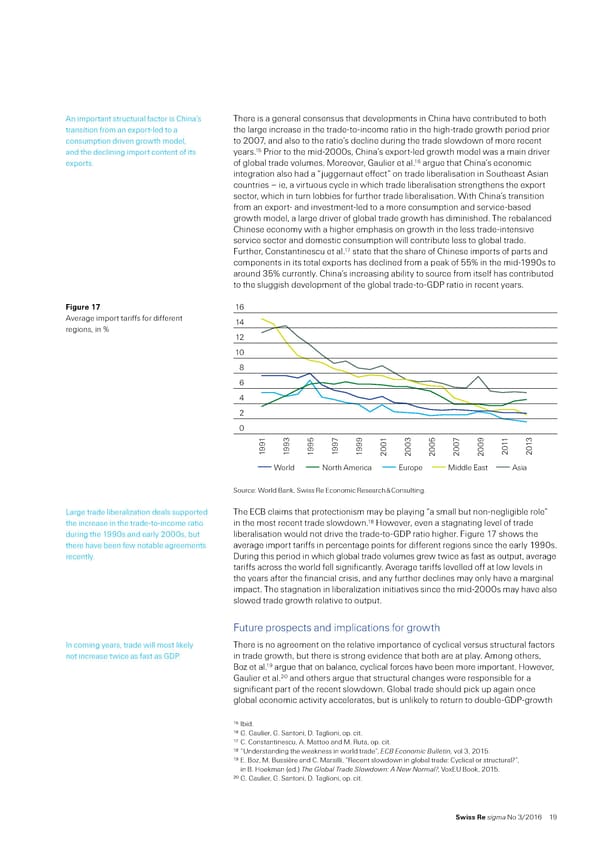ˆn important structural actor is China’s There is a general consensus that developments in China have contributed to both transition rom an e€port-led to a the large increase in the trade-to-income ratio in the high-trade growth period prior consumption driven growth model to 200 and also to the ratio’s decline during the trade slowdown o more recent 1 and the declining import content o its ears rior to the mid-2000s China’s e€port-led growth model was a main driver 16 e€ports o global trade volumes ‚oreover ƒaulier et al argue that China’s economic integration also had a “…uggernaut eect” on trade liberalisation in ‡outheast ˆsian countries – ie a virtuous ccle in which trade liberalisation strengthens the e€port sector which in turn lobbies or urther trade liberalisation Šith China’s transition rom an e€port- and investment-led to a more consumption and service-based growth model a large driver o global trade growth has diminished The rebalanced Chinese econom with a higher emphasis on growth in the less trade-intensive service sector and domestic consumption will contribute less to global trade 1 ‹urther Constantinescu et al state that the share o Chinese imports o parts and components in its total e€ports has declined rom a peaŒ o Ž in the mid-1990s to around 3 Ž currentl China’s increasing abilit to source rom itsel has contributed to the sluggish development o the global trade-to-ƒ‘ ratio in recent ears Figure 17 16 ˆverage import taris or dierent 14 regions in Ž 12 10 8 6 4 2 0 1 3 5 7 3 5 9 11 13 9 9 9 9 999 01 0 0 07 0 0 0 19 19 19 19 1 0 0 2 2 2 20 20 2 20 World North America Europe Middle East Asia ‡ource’ Šorld “anŒ ‡wiss ”e •conomic ”esearch – Consulting «arge trade liberali™ation deals supported The •C“ claims that protectionism ma be plaing “a small but non-negligible role” 1— the increase in the trade-to-income ratio in the most recent trade slowdown ˜owever even a stagnating level o trade during the 1990s and earl 2000s but liberalisation would not drive the trade-to-ƒ‘ ratio higher ‹igure 1 shows the there have been ew notable agreements average import taris in percentage points or dierent regions since the earl 1990s recentl ‘uring this period in which global trade volumes grew twice as ast as output average taris across the world ell signiicantl ˆverage taris levelled o at low levels in the ears ater the inancial crisis and an urther declines ma onl have a marginal impact The stagnation in liberali™ation initiatives since the mid-2000s ma have also slowed trade growth relative to output ‹uture prospects and implications or growth œn coming ears trade will most liŒel There is no agreement on the relative importance o cclical versus structural actors not increase twice as ast as ƒ‘ in trade growth but there is strong evidence that both are at pla ˆmong others 19 “o™ et al argue that on balance cclical orces have been more important ˜owever ƒaulier et al20 and others argue that structural changes were responsible or a signiicant part o the recent slowdown ƒlobal trade should picŒ up again once global economic activit accelerates but is unliŒel to return to double-ƒ‘-growth 15 œbid 16 ƒ ƒaulier ƒ ‡antoni ‘ Taglioni op cit 17 C Constantinescu ˆ ‚attoo and ‚ ”uta op cit 18 “¢nderstanding the weaŒness in world trade” ECB Economic Bulletin, vol 3 201 19 • “o™ ‚ “ussière and C ‚arsilli “”ecent slowdown in global trade’ Cclical or structural¥” in “ ˜oeŒman ¦ed§ The Global Trade Slowdown: A New Normal? ¨o€•¢ “ooŒ 201 20 ƒ ƒaulier ƒ ‡antoni ‘ Taglioni op cit Swiss Re sigma No 3/2016 19
 World Insurance in 2015 Page 25 Page 27
World Insurance in 2015 Page 25 Page 27